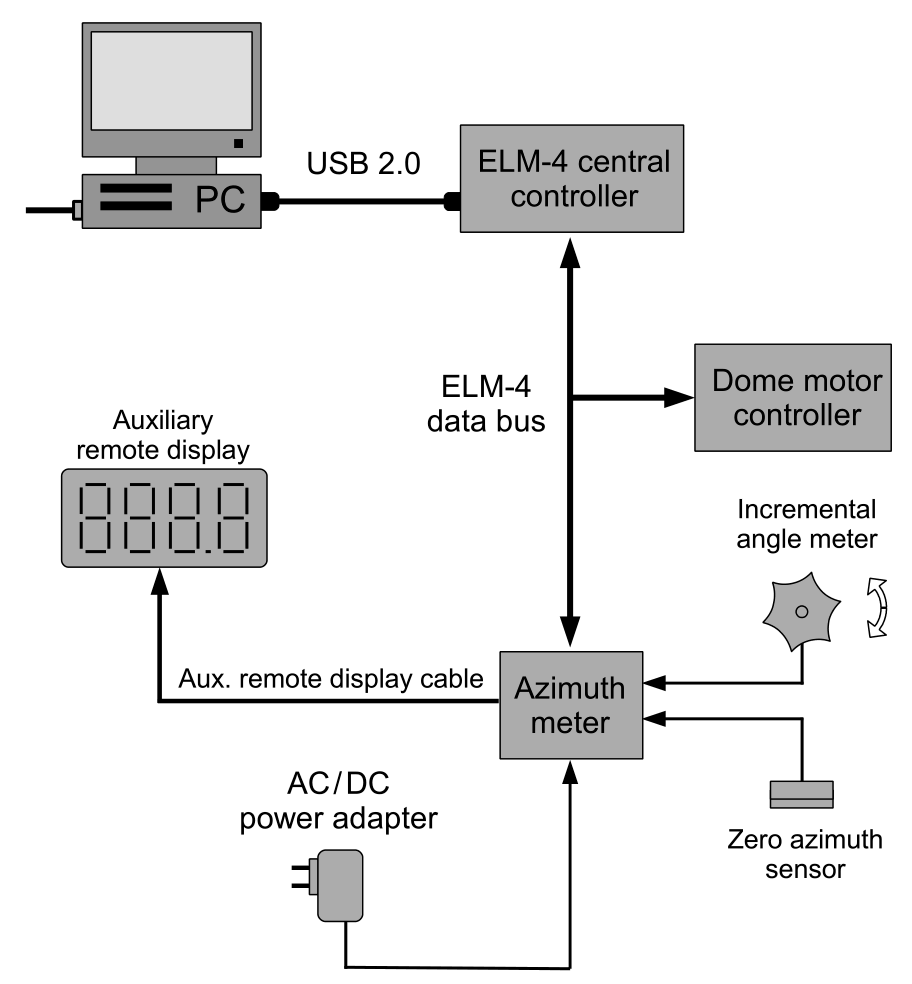One of the essential problems that AS2 solves is automation of observatory dome motion according to telescope pointing. This is performed by AS2 Communicator PC application software, for which it collects two sets of data:
-
Telescope pointing in celestial or ground coordinate system that it gets from any ASCOM compatible telescope control application
-
Dome azimuth that it reads from ELM-4 dome azimuth metering module.
AS2 Communicator uses telescope pointing data to continuously solve a set of 3D geometry equations in order to calculate current ideal dome azimuth. It then compares the solution to actual dome azimuth read from azimuth meter and recalculates the error. Should the error become larger than the preset threshold, it actuates dome motors and positions the dome into a new azimuth angle. When doing this, AS2 Communicator predicts telescope motion in the near future so that it minimizes
dome motor actuation time and frequency.
Dome azimuth error threshold directly influences how frequent dome motors have to be powered on in order to provide unobscured look towards the sky for the telescope. This is in turn dictated by how tightly dome door width matches the telescope aperture - the more equal they are, the more frequently dome azimuth correcting routine has to be initiated, meaning that dome azimuth error threshold must be set to a rather low value (e.g. 0.5° of arch). But if dome door width is significantly larger than the telescope aperture, then more relaxed approach can be taken, meaning that dome azimuth error threshold can be set to a much higher value.
Reading dome azimuth
AS2 Communicator gets information on dome azimuth by reading Azimuth meter module via ELM-4 data bus. The module contains two types of sensors:
-
zero azimuth sensor
-
incremental angle meter.
Zero azimuth sensor is a miniature sealed reed-contact fixed to dome base, that is turned on when a permanent magnet attached to the referent point of the dome passes by it.
Incremental angle meter contains a small wheel mechanically attached to the dome without slipping which is used to measure dome angular motion continually. As ratio between diameters of the measuring wheel and the internal diameter of the dome can vary widely (for various domes), we designed azimuth meter module so that it outputs data in angular degrees rather than in its “raw” internal units. For this to be possible, the module has to poses the information on the exact number of unit steps it observes at the wheel interface for each angular degree of dome movement. Additionally, due to dome mechanical construction metering wheel might be turned “upside-down”, while dome itself might be built at northern as well as at southern Earth hemisphere, so the meter also needs to be able to recognize the positive direction of dome rotation.

In order to make the azimuth meter calibration as easy as possible, we figured out a short and straightforward procedure. The goal is to move the dome so that it triggers the zero azimuth sensor twice, and to do it in “positive” direction. This way, azimuth meter will be able to count the number of unit steps it observes for the full circle of dome rotation, and will be able to recognize the direction in which dome is expected to move while telescope tracks celestial objects. For observatories located at north hemisphere, positive dome motion equals to clockwise direction, while for those located at southern hemisphere, the contrary is true.
The following diagram brings a few more details on this:

a)
Put the dome a few degrees into the “negative side” with respect to the referent zero-azimuth point. For example, if positive dome motion is in the clockwise direction (as in the diagram), put it a few degrees counter-clockwise with respect to “zero”; after the calibration azimuth meter should read something like "Az0 - 5°” for this dome position. If the observatory is located at the southern hemisphere the contrary is truth, i.e. the starting point is where the meter will read azimuth close to “Az0 + 5°” after the calibration.*
Start the calibration procedure by depressing briefly the dedicated push button on the azimuth meter housing, or by issuing the “Calibrate azimuth meter” command from AS2 Communicator.
b) and c)
Move the dome in the positive direction. Actual speed of dome motion is not important. It is even permitted to stop it as azimuth meter will not be confused by that.
d)
Stop the dome a few degrees after it passes the referent zero point for the second time.
This simple procedure can be repeated by the operators as many times as necessary, although the only true reason would be changing the dome mechanical construction. Azimuth meter stores calibration coefficients in its internal non-volatile EEPROM memory. AS2 Communicator is able to perform the whole procedure automatically on request.
A common objection against using incremental motion sensors the designer faces is the possibility that current data will be lost in case of power blackout. In contrast to absolute sensors that do not suffer from this symptom, relative sensors such as azimut meter we designed do require a certain care in order to be able to vercome it. But the problem is not as bad as it might seem - we equipped the azimut meter with a power supply unit with enough backup energy storage (in essence - a large electrolytic capacitor) that enables it to detect external power loss and store current data in its internal EEPROM. The next time the dome motion system is powered up, meter starts monitoring current dome position as if notning odd happened.
As a consequence of what was said in the previous paragraph, there is no need to frequently reset azimuth reading by triggering the zero azimuth sensor. This virtue is also backed up by the fact that meter is able to count up to 10,000 unit steps for the full circle of dome rotation. If mechanical gear ratio between dome circumference and the measurement wheel is chosen wisely, maximum error as low as 360°/10,000 = 0.036° = 2 minutes of arch in dome azimuth reading can be achieved.
Azimuth meter has a dedicated port on its housing to which a simple 4-digit 7-segment LED display with a cable up to 15m long can be attached, by which direct reading of the current azimuth is possible at any moment. Although this is unnecessary if ELM-4 data bus operates ok, it can be useful during system setup, dome calibration etc.
* Please note that for astronomical observatories located at northern hemisphere it is more common to take south instead of north direction as the reference zero azimuth angle Az0.


